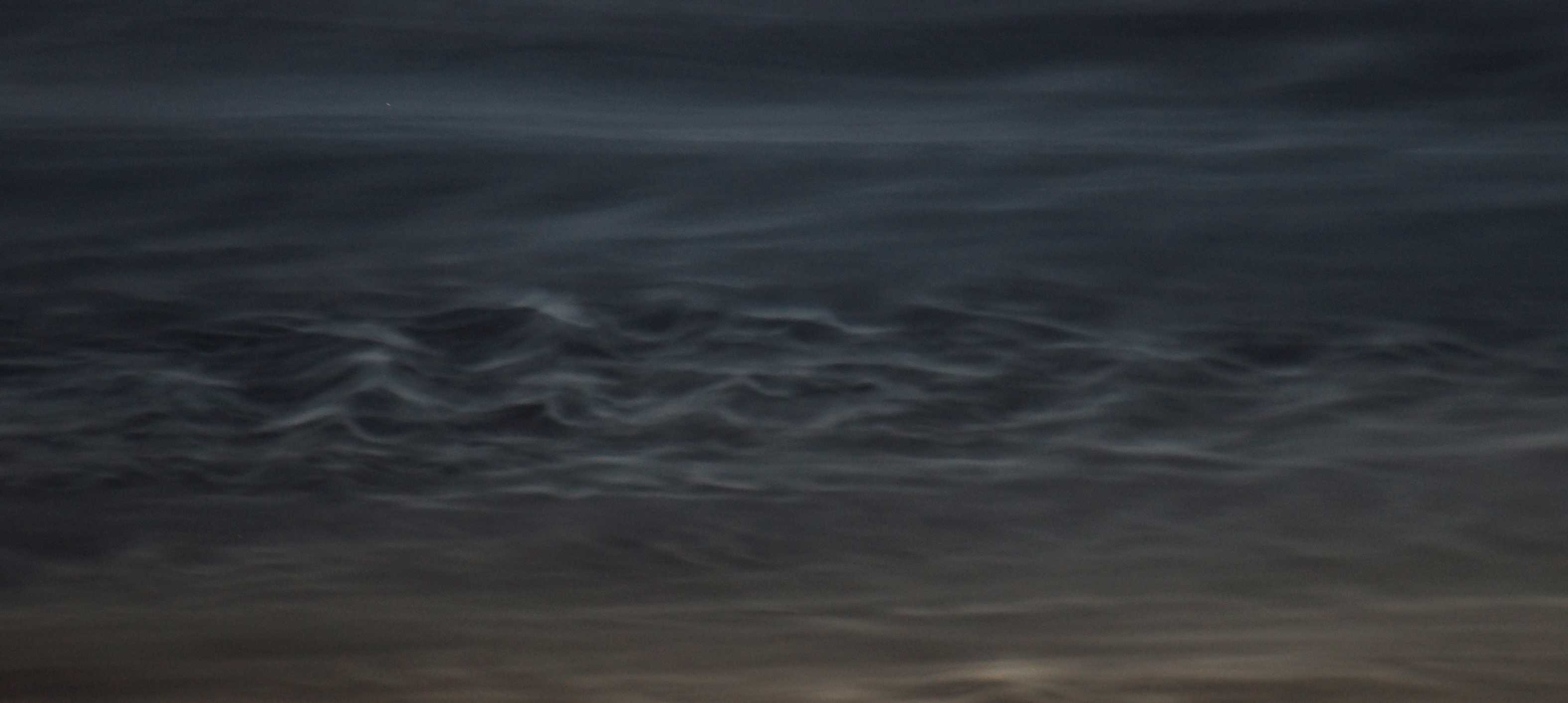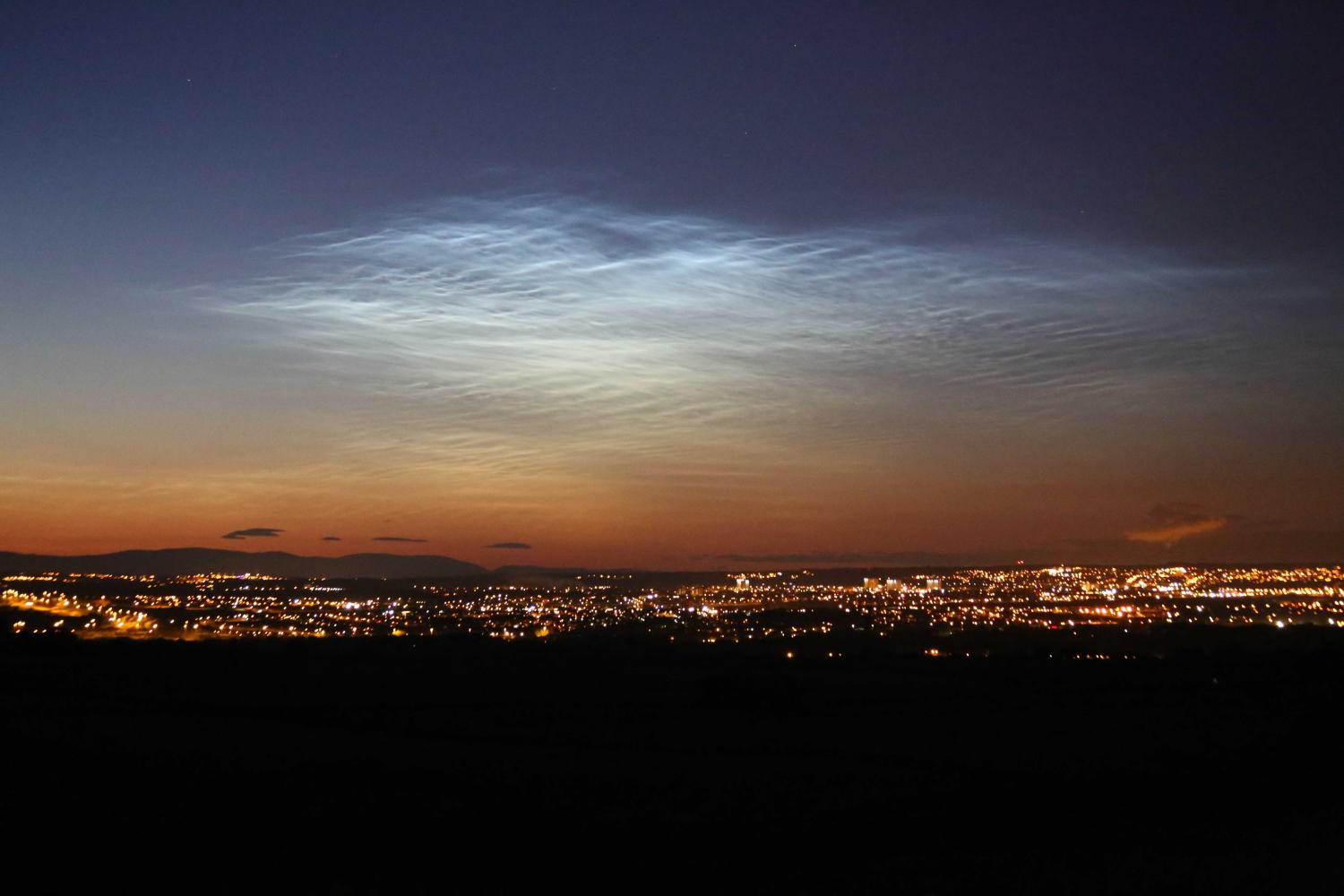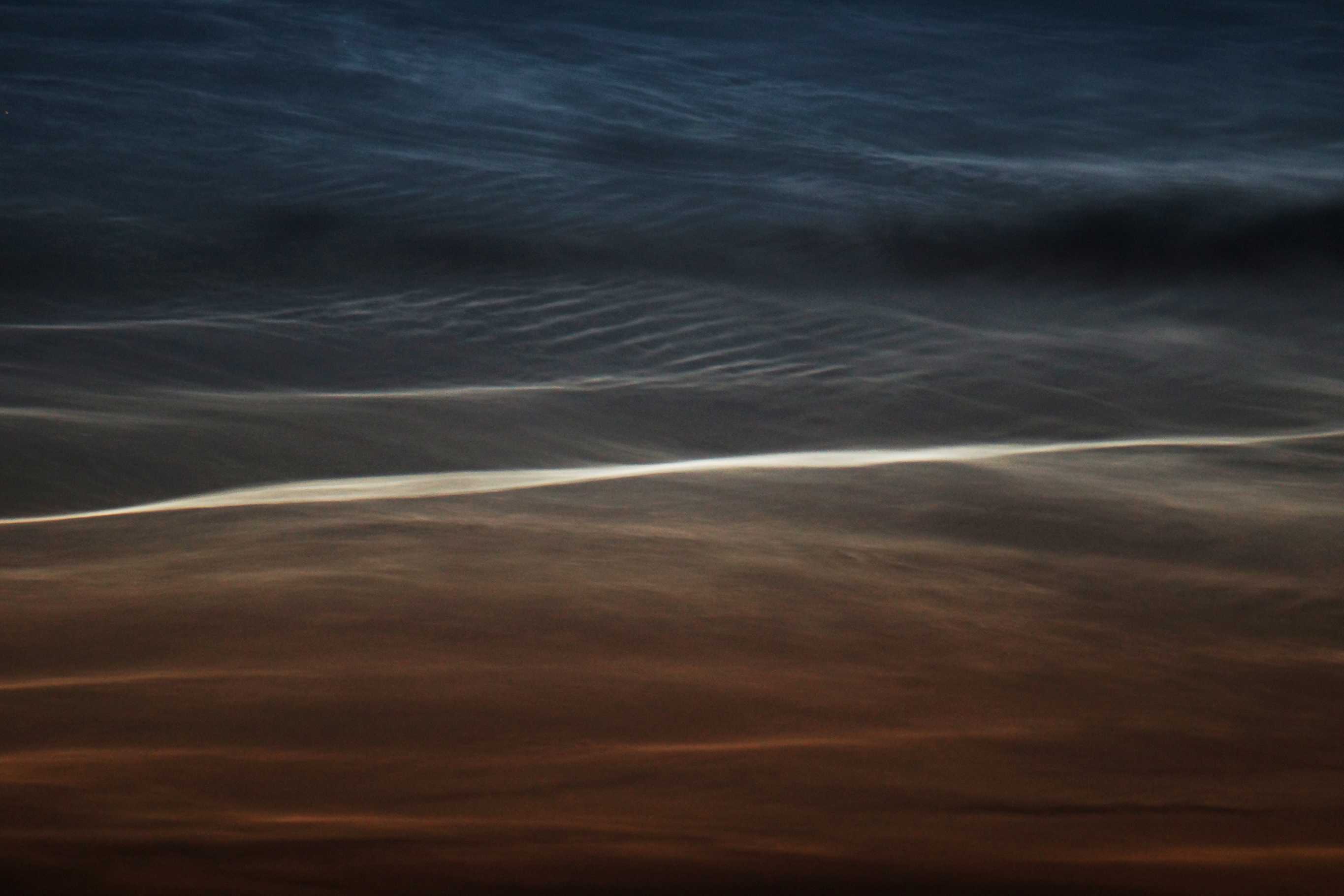© Mark Zalcik
Namao, Alberta, Canada
Latitude: 53° 42' 58'' N
Longitude: 113° 29' 32'' W
09 July 2014 0031 (Local Time)
Camera direction: towards NW
Image P/S code: P.10U.3.3
Image I.D.: 5690
-
Noctilucent cloud type IIIb – billows: wave-like structure with undulations
Type III – billows: these are arrangements of closely spaced, roughly parallel short streaks. There are two types:
– Type IIIa: comprised of short, straight and narrow streaks
– Type IIIb: exhibiting a wave-like structure with undulations
The billow type shown in this picture is type IIIb – a wave-like structure with undulations.
Links in the image description will highlight features on the image. Mouse over the features for more detail.
© Mark ZalcikNamao, Alberta, CanadaLatitude: 53° 42' 58'' NLongitude: 113° 29' 32'' W09 July 2014 0031 (Local Time)Camera direction: towards NWImage P/S code: P.10U.3.3Image I.D.: 5690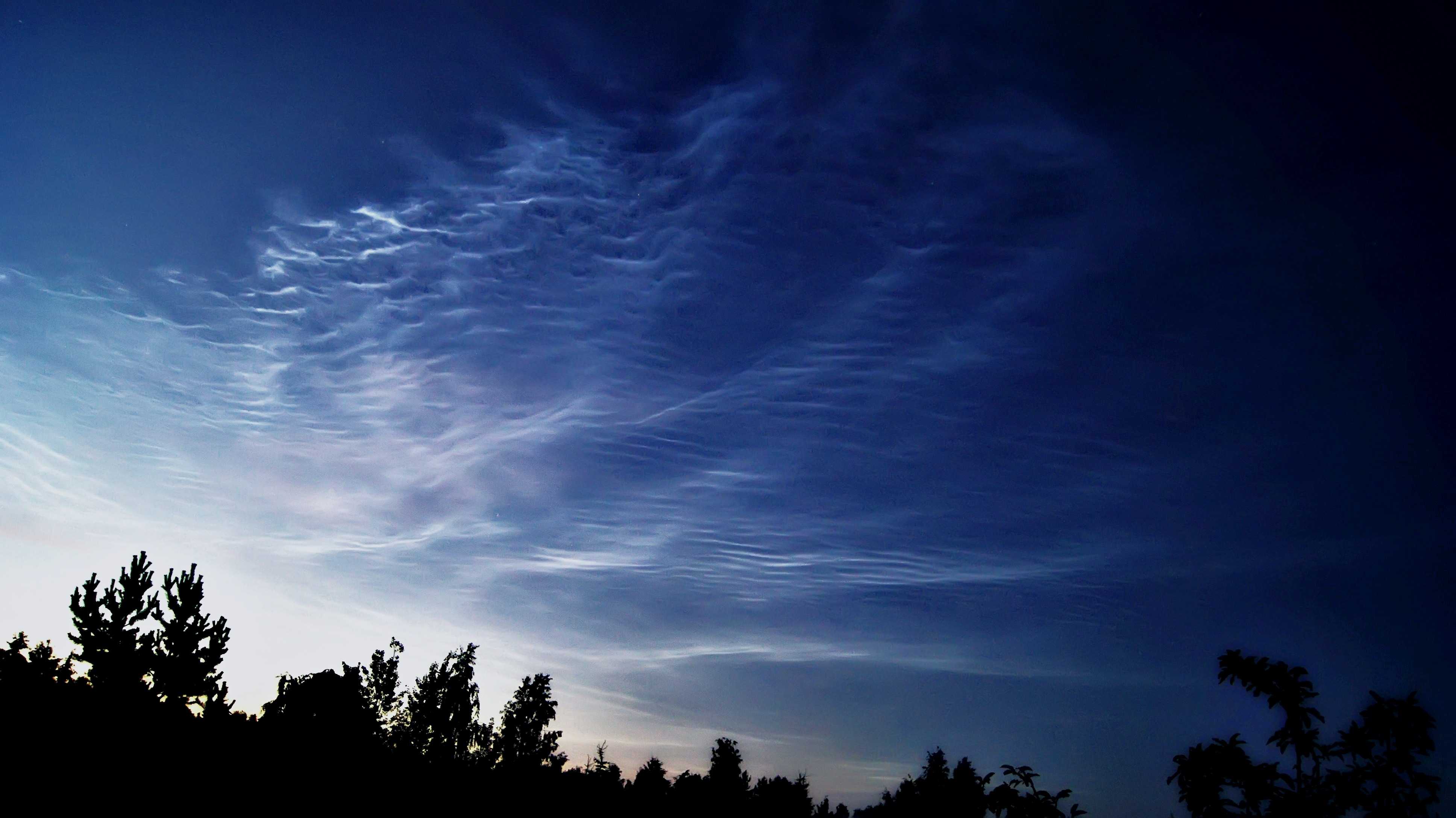
Noctilucent cloud
Noctilucent clouds (NLC) are high-altitude, night-shining clouds that are only visible to observers in mid to high latitudes (approximately 50°N to 65°N or 50°S to 65°S). They only form during the summer when the temperatures in the mesosphere are the coldest.
Noctilucent cloud is distinguished by its typical bluish-white colour. The clouds are brighter than the twilight sky. Billows (type III) are clearly a main feature of this bright display.
Links in the image description will highlight features on the image. Mouse over the features for more detail.
© YakovLeningrad Oblast, Russian FederationLatitude: 59° 52' 54'' NLongitude: 31° 3' 18'' E08 July 2014 0310 (Local Time)Image P/S code: S.10Image I.D.: 5576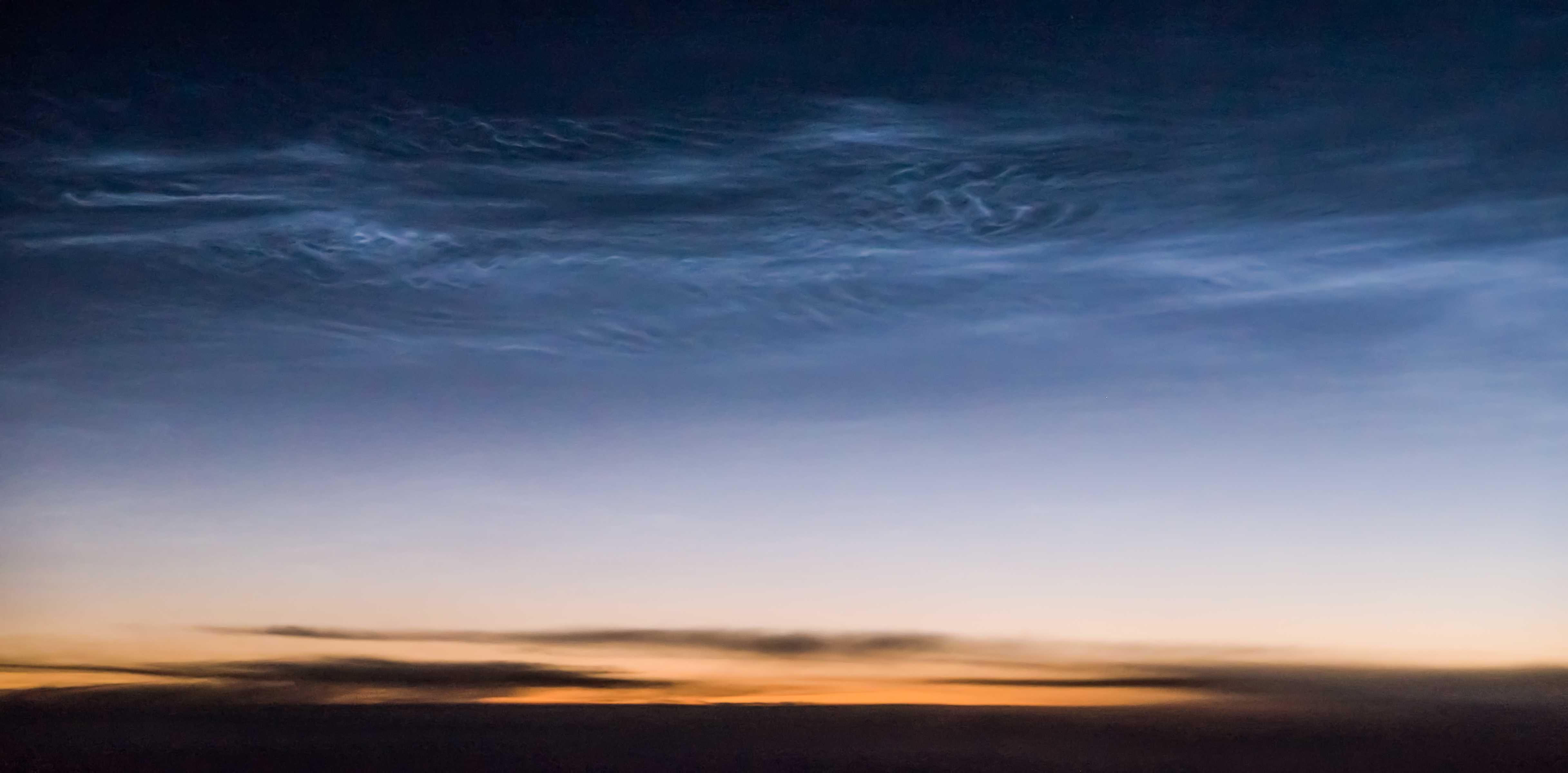
Noctilucent clouds
Noctilucent clouds are seen here from an aircraft. These are high-altitude clouds that form near the mesopause during summertime and are visible to observers in mid to high latitudes when the Sun is below the horizon.
There are bands or streaks with diffuse edges (type IIa) and there is one band with a sharply defined edge (type IIb). Short, straight and narrow billows (type IIIa) are also visible, as too are whirls with a small radius (type IVa), as seen at 4 and 5. Tropospheric clouds in the Earth's shadow appear as dark silhouettes against the background sky.
Links in the image description will highlight features on the image. Mouse over the features for more detail.
© Neil GordonQuébec J0M, CanadaLatitude: 57° 9' 36'' NLongitude: 66° 1' 40'' W15 July 2015 0130 (Local Time)Camera direction: towards NImage P/S code: S.10Image I.D.: 5577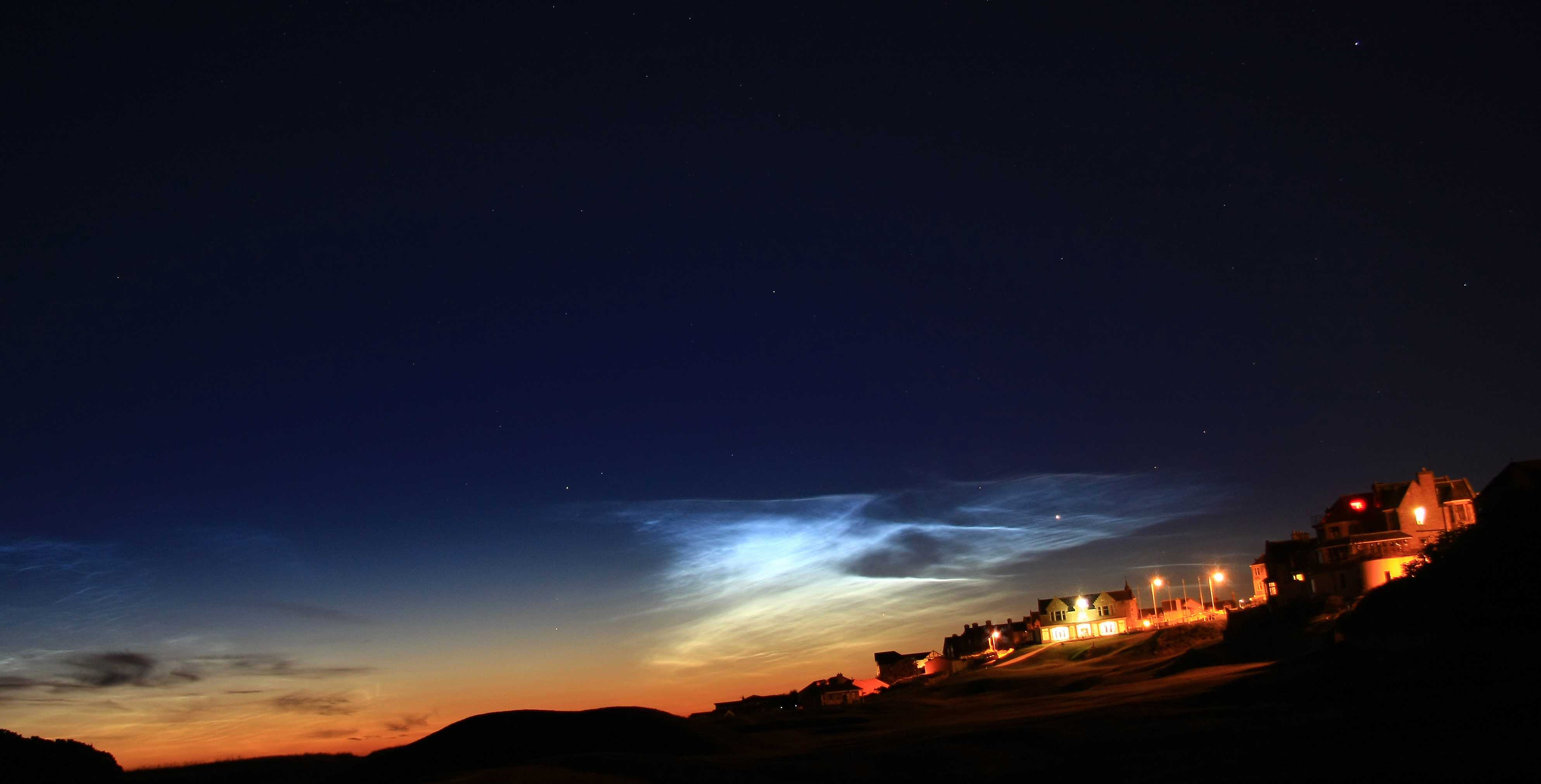
Noctilucent cloud
Noctilucent clouds (NLC) are high-altitude, “night-shining” clouds that are generally only visible to observers in mid to high latitudes (approximately 50°N to 65°N or 50°S to 65°S) for a few months in summer. They occur higher than all other clouds, near the altitude of the mesopause, and are seen against the background of a dark sky when the Sun is well below the horizon, but while the clouds themselves are still illuminated by the Sun.
Several types of NLC appear in this picture. There is a very tenuous background veil (type I), which is faint and lacks any well-defined structure. There are also bands or streaks of cloud (type II), some of which have diffuse, blurred edges (type IIa) and some of which have sharply defined edges (type IIb). Short, straight and narrow billows (type IIIa) cross a band, which together is known as a complex structure of type P. One band is a curved whirl (type IV) and there is a bright area with a complex structure.
Tropospheric clouds in the Earth's shadow appear as dark silhouettes against the background sky. Noctilucent clouds, in contrast, appear brighter than the twilight sky as they are still illuminated at high altitude. A clear identifying feature of noctilucent clouds is their distinctive bluish-white colour.
Generally, noctilucent clouds will be seen close to the horizon. For this early morning view (in the northern hemisphere), the photographer is facing towards the north-east.
Links in the image description will highlight features on the image. Mouse over the features for more detail.
© Nicky MackLossiemouth, Scotland, United Kingdom of Great Britain and Northern IrelandLatitude: 57° 43' 12'' NLongitude: 3° 17' 52'' W18 October 2014 0315 (Local Time)Camera direction: towards NEImage P/S code: S.10Image I.D.: 5578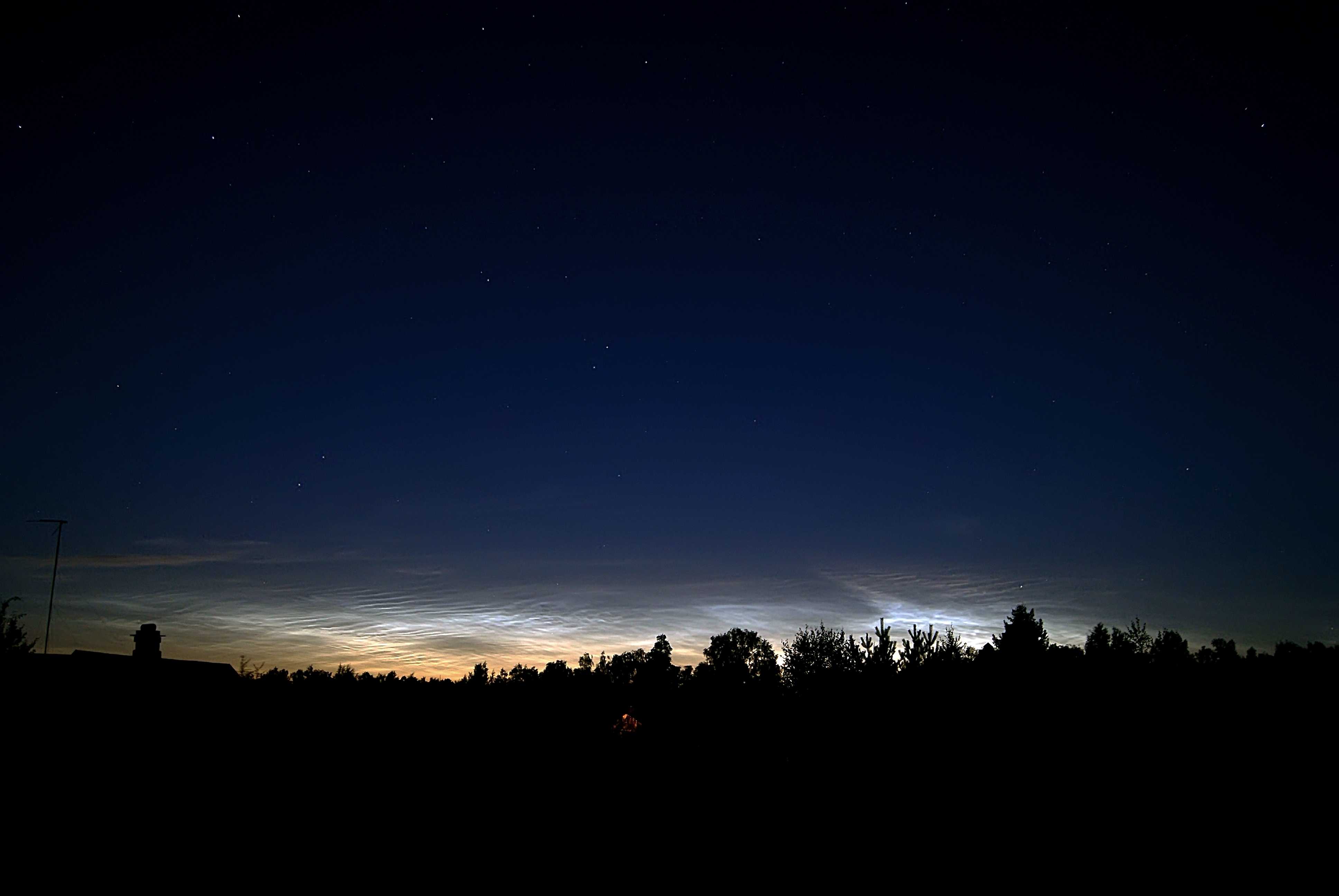
Noctilucent cloud
Noctilucent clouds (NLC) are high-altitude, “night-shining” clouds that are only visible to observers in mid to high latitudes (approximately 50°N to 65°N or 50°S to 65°S). They only form during the summer when the temperatures in the mesosphere are the coldest.
NLC are visible against the background of a dark twilight sky when the Sun is well below the horizon, but the clouds themselves are still illuminated by the Sun. Generally, NLC will be seen close to the horizon (as shown in this picture), typically extending up to around 15° to 20° above the horizon along the twilight arch. However, they can extend to higher elevations.
Noctilucent cloud is distinguished by its typical bluish-white colour. The clouds are brighter than the twilight sky. In this picture, billows (type III) are clearly visible at 2 and 3. A patch of tropospheric cloud appears in silhouette on the left of the picture.
Links in the image description will highlight features on the image. Mouse over the features for more detail.
© YakovLeningrad Oblast, Russian FederationLatitude: 59° 53' 23'' NLongitude: 31° 2' 16'' E08 August 2015 0320 (Local Time)Camera direction: towards NEImage P/S code: S.10Image I.D.: 5579
Noctilucent cloud
This image shows several of the main types of noctilucent cloud: veil, bands, billows and whirls. The sky was clear with good visibility, but also with some low-level tropospheric cloud.
Links in the image description will highlight features on the image. Mouse over the features for more detail.
© Alan C. ToughHopeman, Elgin, Scotland, United Kingdom of Great Britain and Northern IrelandLatitude: 57° 42' 38'' NLongitude: 3° 25' 38'' W09 June 2013 0023 (Local Time)Camera direction: towards NEImage P/S code: S.10Image I.D.: 5580Noctilucent cloud
Noctilucent clouds (NLC) are usually only visible to observers in mid to high latitudes (roughly 50°N to 65°N or 50°S to 65°S) and in the twilight or night sky for a few months in summertime, when temperatures in the mesosphere are the coldest. This photograph was taken in late June, during summer in the northern hemisphere, from a location 55.78°N.
Noctilucent clouds are generally observed during the twilight periods when the Sun is between 6° and 16° below the observer's horizon. It is during this period that the background sky is dark enough for the cloud to be seen, yet the high-altitude clouds are still illuminated by sunlight.
Typically what sets noctilucent clouds visually apart from tropospheric clouds is their visibility in the night and their obvious, and sometimes bright, blue-white colour. The low-level tropospheric clouds at 2 and 3 are within the Earth's shadow and they stand out as dark silhouettes against the relatively brighter background sky. In contrast, noctilucent clouds are always brighter than the twilight sky. Near the horizon, they may have a reddish tint. Two main types of NLC are shown here: bands (type II) – these are long streaks – and billows (type III), seen at 7 and 8 – these are closely spaced, roughly parallel streaks.
Links in the image description will highlight features on the image. Mouse over the features for more detail.
© Ewan KaneEast Kilbride, Scotland, United Kingdom of Great Britain and Northern IrelandLatitude: 55° 46' 49'' NLongitude: 4° 8' 48'' W23 June 2015 2247 (Local Time)Camera direction: towards NWImage P/S code: P.10Image I.D.: 5581Noctilucent cloud type IIb – bands with sharply defined edges
The principal noctilucent type in this picture is type IIb – bands with sharply defined edges (seen at 1, 2 and 3). The brightest band across the centre of the picture appears twisted or braided.
The short, straight and narrow streaks just above the centre of the image are type IIIa – billows.
Links in the image description will highlight features on the image. Mouse over the features for more detail.
© Mark ZalcikNamao, Alberta, CanadaLatitude: 53° 42' 58'' NLongitude: 113° 29' 32'' W28 June 2014 0243 (Local Time)Camera direction: towards NImage P/S code: P.10Image I.D.: 5691
Noctilucent cloud
This photograph shows a very bright display of noctilucent clouds. The clouds were sufficiently bright to illuminate ground features and cast faint shadows. It therefore rates as 5 on the 5-point brightness scale.
The main types shown in the picture are type IIb – bands (streaks with sharply defined edges); type IIIa – billows (short, straight and narrow streaks); type IVa – whirls (whirls of small radius); type IVb – whirls (simple curves of 3° to 5°); and complex type O.
Ground fog, also known as shallow fog, can be seen in the distance over the ground.
Links in the image description will highlight features on the image. Mouse over the features for more detail.
© Bill WardDalry, North Ayrshire, Scotland, United Kingdom of Great Britain and Northern IrelandLatitude: 55° 41' 7'' NLongitude: 4° 39' 8'' W03 July 2011 0115 (Local Time)Camera direction: towards NImage P/S code: S.10Image I.D.: 5692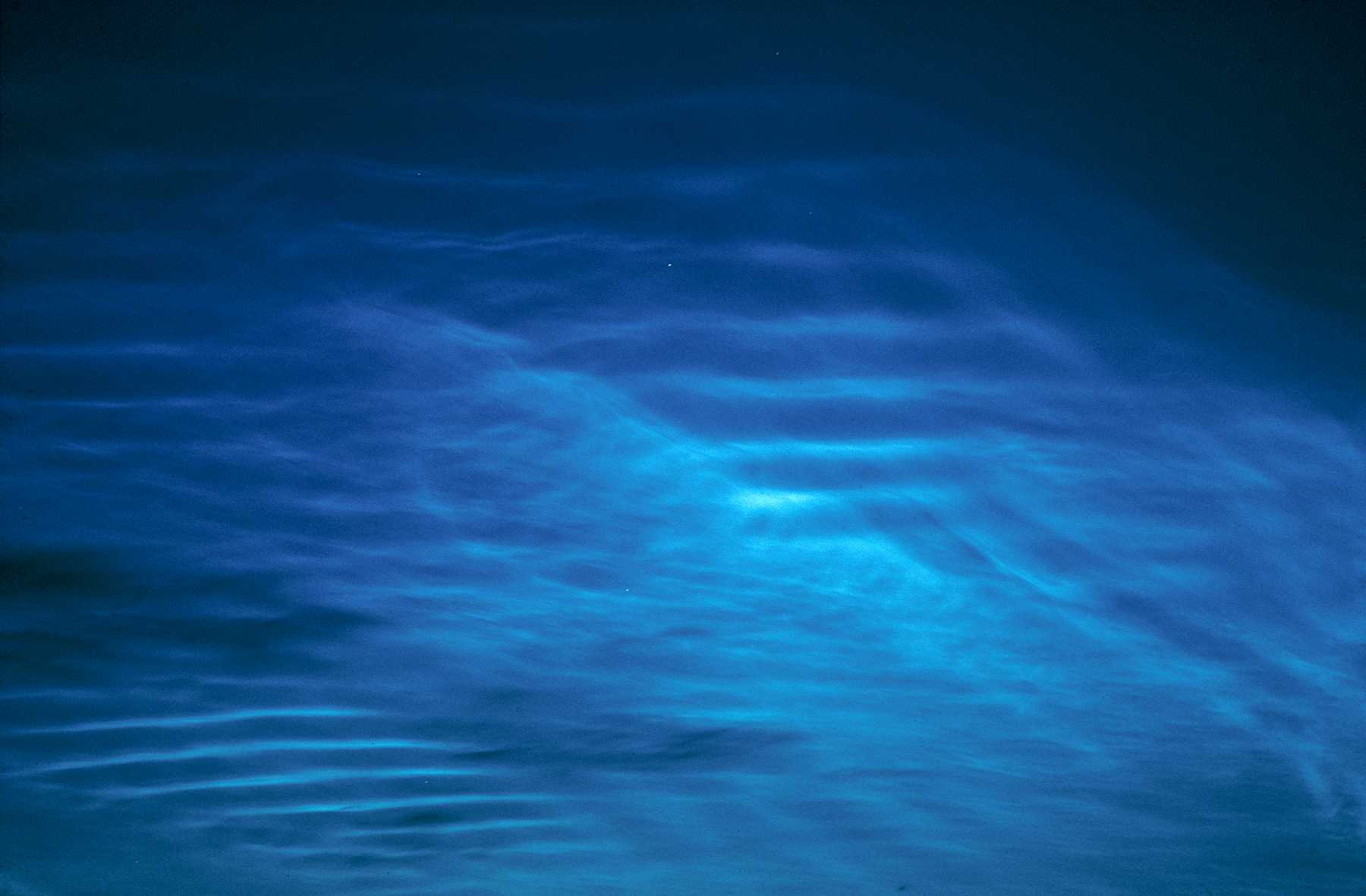
Noctilucent cloud: type IIIb
The principal type of noctilucent cloud in this picture is type IIIb – billows: a wave-like structure with undulations (seen at 1 and 2). There are also diffuse bands of type IIb and a complex structure of type S (knots) in the centre.
Links in the image description will highlight features on the image. Mouse over the features for more detail.
© Pekka ParviainenKustavi, FinlandLatitude: 60° 32' 42'' NLongitude: 21° 21' 19'' E09 August 1988 0027 (Local Time)Image P/S code: S.10Image I.D.: 5793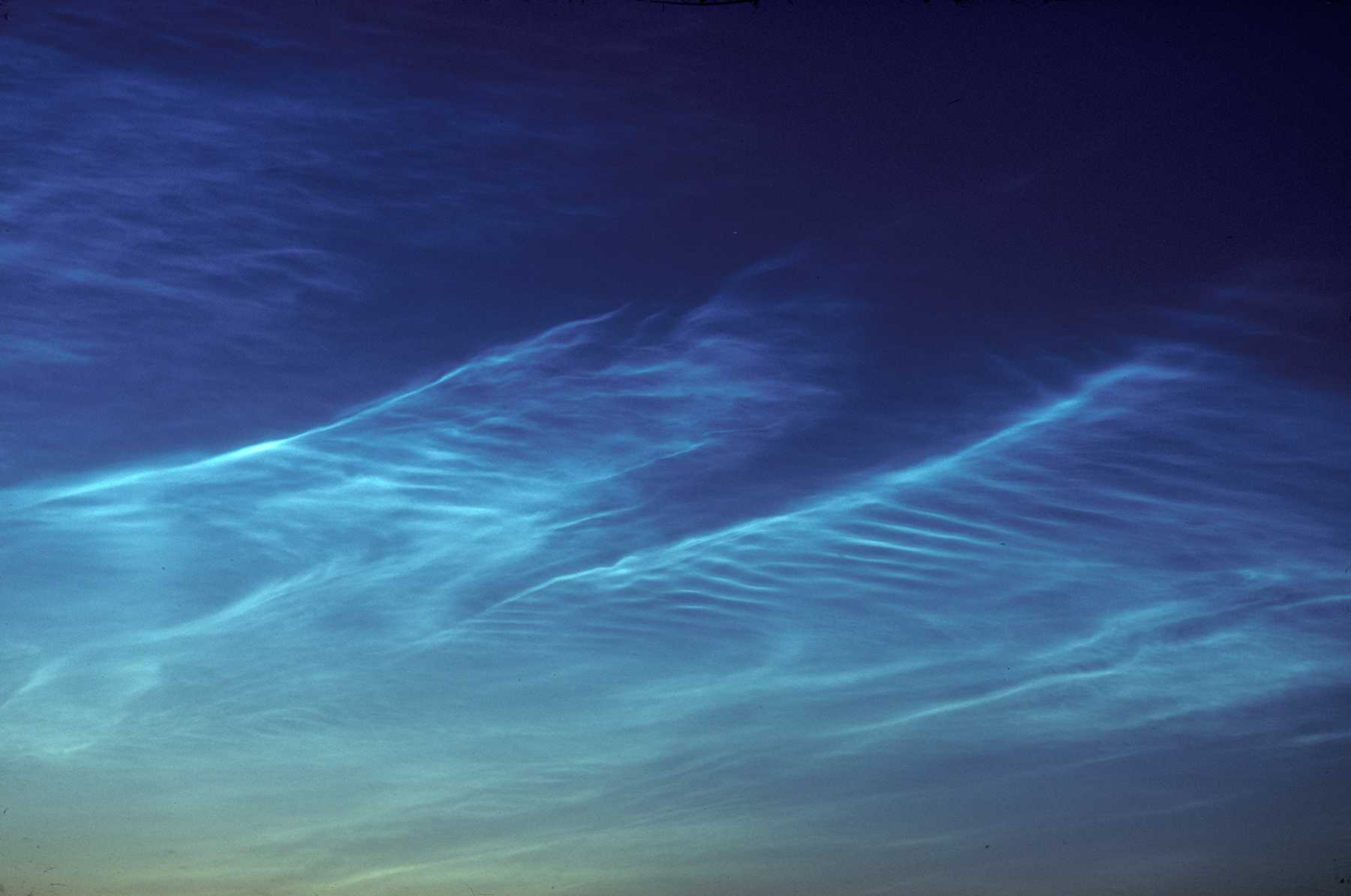
Noctilucent cloud: type IIIa
Seen here are type IIIa noctilucent clouds – billows: short, straight and narrow streaks. There are also bands of type IIb at the side. In the upper left corner, there is a complex structure of type O.
Links in the image description will highlight features on the image. Mouse over the features for more detail.
© Pekka ParviainenKustavi, FinlandLatitude: 60° 32' 42'' NLongitude: 21° 21' 19'' E21 July 1989 2315 (Local Time)Image P/S code: S.10Image I.D.: 5797
